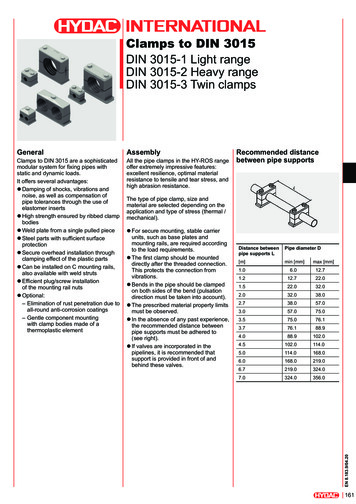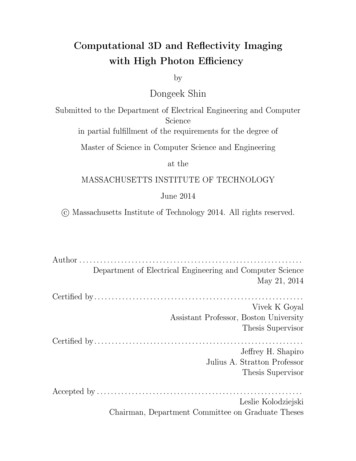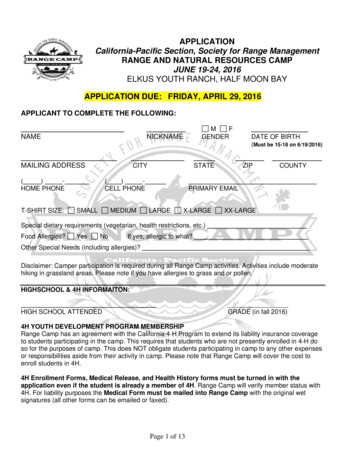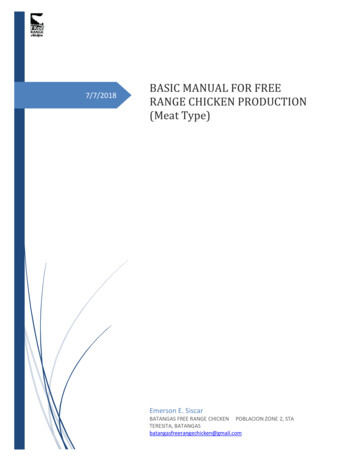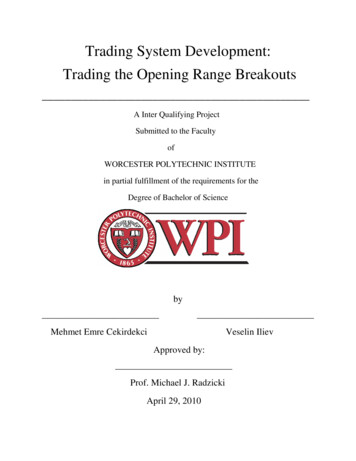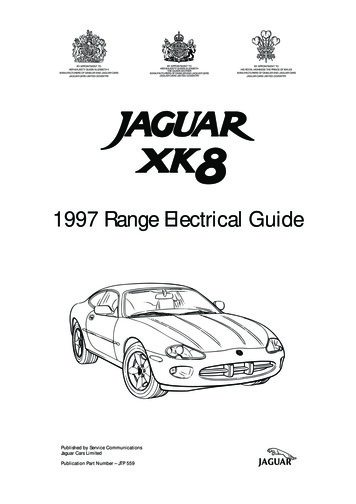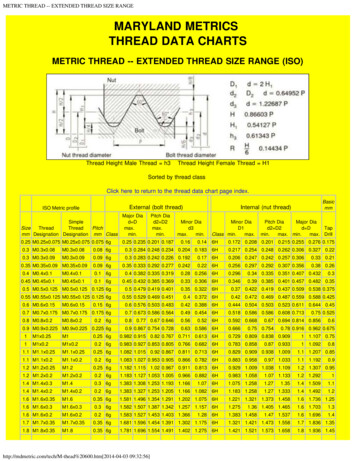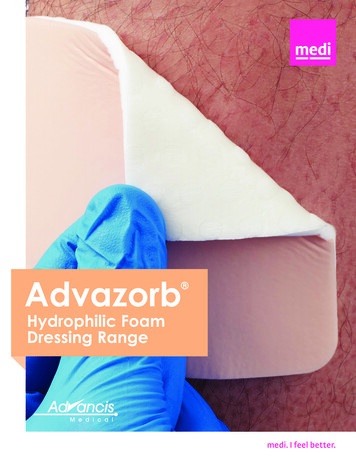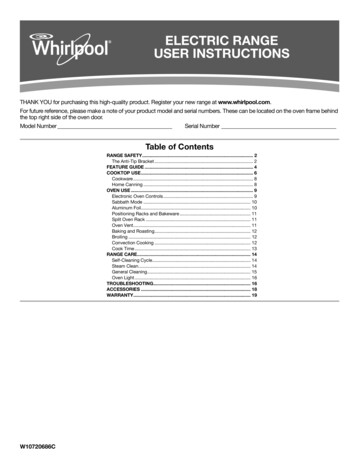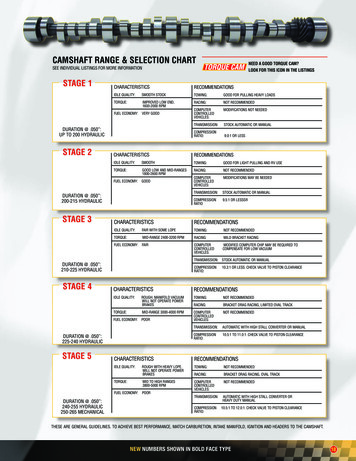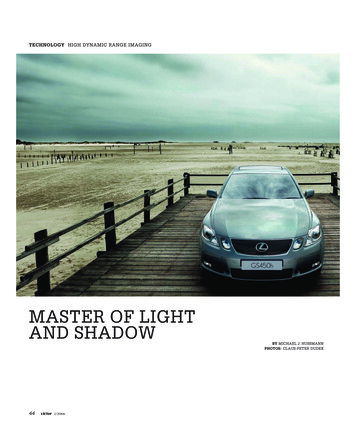
Transcription
21503 E 44 49 Tech HDRIneu.QXD05.09.200611:32 UhrSeite 44TECHNOLOGY HIGH DYNAMIC RANGE IMAGINGMASTER OF LIGHTAND SHADOWBY MICHAEL J. HUSSMANNPHOTOS: CLAUS-PETER DUDEK441/2006
21503 E 44 49 Tech HDRIneu.QXD05.09.200611:33 UhrSeite 45High Dynamic Range Imaging (HDRI) is designed to show all the tonalvalues in a picture, from the brightest lights to the darkest shadows.The potential that HDRI, in combination with panorama photographyand 3D modeling, opens up for a new kind of photography is shown bythe work of Claus-Peter Dudek for his clients in the automobile industry.Photography means “to write withlight“, but photographic techniquescan only register a small percentageof light values between the brightestdaylight and the darkest night. Printfilm can reproduce a contrast rangeof approximately 10 aperture stops,i.e. a relationship of about 1 to 1000;slide film has an even lower dynamicrange. In this matter, the image converters of digital cameras are not, asoften suggested, handicapped; a digital camera can reproduce abouttwelve f/stops, thus a relationship ofapproximately 1 to 4000. This dynamic range is sufficient for most applications, but even the most everydaysubject can overwhelm a digital oranalog camera with the richness ofits contrasts.This includes the view lookingfrom inside a room to the outside, aswell as the view from outside into thecomparatively dark interior, subjectsin which the sun or artificial lightsources are visible in the picture,or simply subjects that are partly inthe dark, partly in bright sunlight.Whenever a subject is not illuminated homogeneously and there arecontrasting light conditions in different parts of the picture, the contrastcan easily surpass the camera’s dyna-mic range; a tonal spectrum fromone to several million is not a rarething. Photographing such subjectsis always based on a compromise – anexposure on the lights leads to anoverall underexposed picture, whilean exposure on the darks results inblown-out highlights.Our eye can also only perceive asmall percentage of the tonal rangeat once and is limited in a similar wayto the image converter of a camera –but there is one element where oureyes function differently, namelythat they only focus on a small angle,scanning the environment to register the overall scenery. While oureyes leap from detail to detail, theyadapt to the varying light; from theindividual impressions registeredThis Lexus was never at the beachof St. Peter Ording, nor was itever in photographer Claus-PeterDudek’s studio. HDRI panoramaphotography and 3D modeling mergevirtuality with reality1/200645
21503 E 44 49 Tech HDRIneu.QXD05.09.200611:33 UhrSeite 46TECHNOLOGY HIGH DYNAMIC RANGE IMAGINGthis way, our brain assembles a complete picture and reproduces anexceptionally high contrast range.The human eye thus knows neitherover- nor underexposure, nor limitsto the differentiable tonal spectrum.CREATING HDREXPOSURESIn order to reproduce a similarly 1high dynamic range with photographic means, you would haveto expose the same subject with differing exposure settings, thussimulating the dynamic adaptationof the eye. Every exposure registers adifferent part of the tonal spectrum –in a fast one, the detail in the lights ismaintained, while in a longer one461/2006the shadow will be well differentiated. The tonal values of theindividual frames in the exposureseries overlap, and when you mergethem into an HDR picture in animaging program they can cover anygiven tonal range – the more variedthe exposures, the larger the desiredcontrast.Regardless of how high the dynamic range can get, printing procedures cover only five aperturestops and even the presentation onthe computer screen cannot measureup to the contrast range of the actualdata. In order to reproduce an HDRimage truthfully, its tonal value hasto be compressed to the respectivefew f/stops that can be differentiatedin print or on the computer monitor.A mere compression of the contrastswould result in flat images – if thebrightest lights and the darkestblacks were separated by only a fewf/stops, the reproduction of tonal values would be limited to minimalbrightness differences across most ofthe image.For this reason you would emphasize the most important part of thetonal spectrum at the cost of the remaining tonal values, whereby youcan compress individual elements ofthe picture separately from one another in an attempt to reproduce, tosome extent, the real contrast rangein spite of the limitations of printmediums. The quality of an HDRimage largely depends upon this laststep. Frequently, a photographergoes for a spectacular effect but misses the actual point of HDRItechnology, which is to up the photographic tonal reproduction to thelevel of the ability of the human eye.HDR EXPOSURES INTHE PHOTOGRAPHYOF AUTOMOBILES2 The new photographic potentialthat arises with HDRI becomes clearwhen we look at the work of ClausPeter Dudek, photographer in Hamburg , as he is hired by car companiesto fuse HDRI, panorama photography and 3D modeling into a flexibletechnique for product visualization.One of Dudek’s specialties is in photographing new cars in attractive
21503 E 44 49 Tech HDRIneu.QXD05.09.200611:34 UhrSeite 47The shiny paintjob of the virtualLexus in the foreground reflectsthe scenery behind the viewer.Even under strong magnificationyou would not be able to tell the3D model apart from the real carsparked in the back right1/200647
21503 E 44 49 Tech HDRIneu.QXD05.09.200611:35 UhrSeite 48TECHNOLOGY HIGH DYNAMIC RANGE IMAGINGsettings – commissions that can onlybe realized by surmounting a number of challenges. Transportingprototypes to a photo shoot on location is difficult, often impossible.The only alternative that generallyremains is to photograph the vehiclein the studio and later superimpose itonto an outdoor image. The lightingin the studio thus has to be adaptedto the light conditions of the location, and, in order to accentuatecritical details effectively, several differently illuminated exposures mustbe merged before the result can bemounted into the scenic shot.After that, convincing shadowsand reflections have to be retouchedinto the picture – a particularly sophisticated task, because the effect ofthe paint finish relies heavily uponthis. If the client desires last minutechanges – be it a different configuration, an alternate paint finish or afinal change to design details – thenthe work has to start all over again.This is how Dudek used to work. Today, a 3D model of the car frequentlyreplaces the elaborate studio shoot.These high-detail 3D models areavailable as a byproduct of industrialproduction and, if need be, only haveto be rendered into a photo-realisticformat. In the ideal scenario themodel can be used for the exteriorand interior views, as well as forother details in between – allowingyou, for instance, to present the carwith an open door, complete withlock, handle and window button.The photographer chooses thecomposition in which the car isto be embedded from the HDRpanorama taken on the beach inSt. Peter OrdingAdapting the image to the 3Dmodel requires a fair amount ofretouching; the existing tiremarks have to be adapted to thewheelbase of the LexusThe 3D software cancalculate from the brightnesslevels captured in the HDRpanorama how the shadow iscast by the carTHE PHOTOGRAPHICTECHNIQUEEmbedding a 3D render in a pho- 3tographed environment obviouslyrequires more than conventionalphotographic means – at least if youwant credibility. The outdoor shotrelied upon a specialized camera, aSpheroCam HDR by Spheron VR AGin Waldfischbach-Burgalben, Germany. By rotating its CCD scanlinethe SpheroCam HDR exposes a 360degree panorama, taking only a fewminutes even at the highest qualitysetting. With a fisheye lens mountedvertically, the camera registers anangle of 180 degrees vertical and canthereby create a complete sphericalpanorama. Thanks to automatic exposure sequences, the HDR versionof the SpheroCam can extend the dynamic range to 26 f/stops, making ita precise measuring tool for all lightconditions, from direct sunlight toabysmal blackness. Using a secondpanorama taken from a slightly altered angle, you can, per triangulation,calculate the distance between any481/2006From the known materialcharacteristics of the car bodythe 3D software can computea realistic view of the model car;the reflections show the realscenery including elements thatare not shown in the compositionbut which were captured in thespherical panoramagiven picture detail and the cameraby marking the respective positionsin both panoramas. In spite of thepanorama camera being quite fast,the lighting may change during theexposure; clouds might move beforethe sun. In such cases the brightnessdifferences are either corrected inpostproduction or the exposure sequence is simply repeated. Afterexposure, the control software of theSpheroCam removes the reproduction errors caused by the fisheye lensfrom the picture; then it is retouchedmanually, whereby the camera tripod and its shadow are eliminated.REALITY MEETSVIRTUALITYThe SpheroCam HDR provides theconditions for the photo-realisticrendering of the car, which is placedvirtually in the center of the panorama – in other words, precisely wherethe camera had been standing, sothat you don’t have to retouch thatarea; but smaller deviations from thisposition are also possible. The panorama not only fully reproduces theenvironment, allowing you to designrealistic reflections and the like, it also registers the intensity of the lightthat falls onto the car from everyangle. Unlike conventional cameras,which merely approach an authenticreproduction of tonal values, theSpheroCam HDR can measure alllight values from the deepest shadowup to a 67.108.864-times brightersource. From this data, the Spheronsoftware can calculate a light field tohelp Maya, a 3D modeling software,reproduce natural-looking light andshadow effects. And not only do thereflections look natural, they are natural – they are reflections that wereactually there, behind the viewer, asthe spherical panorama capturedthese, as well. The 3D applicationcan now generate any given view,showing the virtual car parked in
21503 E 44 49 Tech HDRIneu.QXD05.09.200611:36 UhrSeite 49HDRI – AT A GLANCE1HOW AN HDR IMAGE IS MADEA digital camera reproduces alimited dynamic range; but whena series is produced with variedexposure settings, every exposurecaptures a different part of theoverall tonal spectrum. Combiningthem into a sandwich, the dynamicrange of the resultant picture canbe as big as you want it2THE CAR MODELIndustrial production often useshighly detailed three-dimensionalmodels containing componentsthat are not even visible to theviewer, such as the window buttonand the door lock3THE SPHEROCAM HDRThe motor-controlled panorama camera rotates around its ownaxis while registering 180 degrees vertical with a vertically mountedfisheye lens. By means of automatic exposure sequences thecamera can differentiate a contrast range of up to 26 aperture stopsPost-manipulating the panorama image: once theexposure has been controlled in this histogram (right)the panorama picture has to be equalized (above)authentic scenery – you can view itfrom all angles, including the bird’seye view, the interior view and theview out of the car. An HDR panorama and a 3D model enable you togenerate multifold perspectives, andyou can easily present an alternatively configured or painted model indifferent environments. Last minutechanges, as ordered by the client,thus represent no major challenges.Claus-Peter Dudek not only usesthis technology to produce individual shots – posters and the like – forprint campaigns, but also for moviesand interactive online presentations:virtual camera rides around the car,navigable panoramas, and “configurators“ for the prospective carpurchaser, allowing him, with theclick of the mouse, to switch betweenthe countless car interior and exterior configurations, shown perfectlyrendered in a genuine backdrop.THE IMAGINATIVE EYEThis kind of photography has little incommon with classic photography.Today even photographs taken theconventional way are often composed of several, differently exposedpartial views. This blurs the bordersbetween traditional technology anda hybrid version of photography andother procedures. Yet, the specificphotographic character of this modus operandi is maintained, becausethe photographer still has many ofthe same tasks. The ostensible photois indeed a computer- generated viewof a chiefly virtual reality, but thephotographer can and must accesshis studio knowledge. This enablesthe photographer to consciously addlight sources with predefined characteristics to the virtual scene. He canplace brighteners that virtually reflect the light that was presentduring the shoot; and the panoramaexposure already challenges his imaginative eye. As the photographerexposes the background of a subjectthat, when starting out, only existsin his head, he has to anticipate potential problems and conflicts thatmay arise during the montage.3D modeling is not a universal solution to all photographic problems.Rather, it is limited to subjects fromindustrial production, which are fairly easy to model and already exist asreference for the real-life product.What’s more, as realistic as the generated images then may be, when itcomes to precisely reproducing thetiniest details of form and fabric, virtual technology still has its limits, atwhich point Claus-Peter Dudek simply grabs his Hasselblad H2D-39.1/200649
individual frames in the exposure series overlap, and when you merge them into an HDR picture in an imaging program they can cover any given tonal range – the more varied the exposures, the larger the desired contrast. Regardless of how high the dyna-mic range can get, printing pro-cedures cover only five aperture stops and even the presentation on

